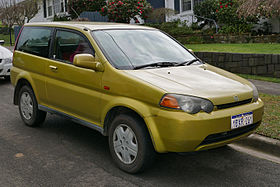HR-V
| Honda HR-V | |
|---|---|
 |
|
| Overview | |
| Manufacturer | Honda |
| Production | 1998–2006 2014–present |
| Model years | 1999–2006 2015–present |
| Body and chassis | |
| Class | Subcompact crossover SUV |
| Body style | 3-door crossover (first generation) 5-door crossover |
| First generation | |
|---|---|
 |
|
| Overview | |
| Production | 1998–2006 |
| Body and chassis | |
| Body style | 3 door wagon (GH1 & GH2) 5 door wagon (GH3 & GH4) |
| Layout |
FWD (GH1 & GH3) Real Time AWD (GH2 & GH4) |
| Related |
Honda Logo Honda City Honda Capa |
| Powertrain | |
| Engine | 1.6 L D16A I4 SOHC 1.6 L D16W I4 VTEC SOHC |
| Transmission |
Honda Multimatic S 5-speed manual |
| Dimensions | |
| Wheelbase | 2,350 mm (92.5 in) (3-door) 2,450 mm (96.5 in) (5-door) |
| Length | 4,000 mm (157.5 in) (3-door) 4,110 mm (161.8 in) (5-door) |
| Width | 1,695 mm (66.7 in) |
| Height | 1,695 mm (66.7 in) |
| Curb weight | 1,200–1,300 kg (2,646–2,866 lb) |
| Chronology | |
| Successor | Honda Crossroad (Japan) |
| Second generation | |
|---|---|
 |
|
| Overview | |
| Also called | Honda Vezel (Japan and China) |
| Production | 2014–present |
| Model years | 2015–present |
| Assembly |
Sumaré, Brazil Campana, Argentina Celaya, Mexico (Feb 2015) Guadalajara, Mexico (2017) Yorii, Saitama, Japan Karawang, Indonesia Alor Gajah, Malaysia Gurgaon, India (Honda Automobile India) Swindon, United Kingdom, Ayutthaya, Thailand |
| Designer | Manabu Konaka (2012) |
| Body and chassis | |
| Body style | 5-door crossover |
| Layout |
Front-engine, front-wheel-drive Front-engine, all-wheel-drive |
| Related |
Honda Fit Honda XR-V Honda WR-V |
| Powertrain | |
| Engine | 1.5 L L15Z6 I4 1.5 L L15B I4 1.8 L R18Z9 I4 |
| Transmission | 6-speed manual CVT automatic |
| Dimensions | |
| Wheelbase | 2,610 mm (102.8 in) |
| Length | 4,295 mm (169.1 in) |
| Width | 1,770 mm (69.7 in) |
| Height | 1,605 mm (63.2 in) |
| Curb weight | 1,180–1,270 kg (2,601–2,800 lb) |
| Chronology | |
| Predecessor |
Honda Element (US) Honda Crossroad (Japan) |
The Honda HR-V is a subcompact crossover SUV produced by Honda spanning two generations. The first generation HR-V was based on the Honda Logo and sold in Japan and selective Asia-Pacific markets between 1999 and 2006. The second generation HR-V is based on third-generation Honda Fit and went on sale in North America, Australia, Brazil, and selective Asian markets in 2015. The second generation HR-V is largely identical to the JDM Vezel which went on sale in late 2013.
The abbreviation HR-V, according to Honda's HR-V history website, officially stands for Hi-rider Revolutionary Vehicle, while the other stands for Hip and Smart Runabout Vehicle. The HR-V was introduced to cater for the demand for vehicles with the benefits of SUVs (in particular its larger cousin CR-V), such as increased cargo room and higher visibility, along with the maneuverability, performance and fuel economy of a smaller car.
The HR-V was built on the supermini platform used by the Honda Logo, while the larger CR-V was built on the Civic platform. Known as one of the earliest low emissions vehicles (in terms of nitrogen oxides) and unique character.
Designed as the "Wild and Joyfull J-WJ" concept vehicle and exhibited at the Tokyo Motor Show in 1997, the HR-V emerged as a futuristic and lightweight cross-country vehicle in 1998, exclusive to Honda dealership network called Honda Verno in Japan. The Honda HR-V was soon put into production due to its popularity, compliance with Japanese Government dimension regulations, and marketed toward a younger demographic as the "Joy Machine" in 1999. The HR-V was shipped to Europe with either a Honda D16W1 type 1.6L SOHC or a four-wheel drive SOHC VTEC Honda D16W5 type engine. An automatic continuously variable transmission gearbox was also an engine option, however, the main criticism of the HR-V was the lack of a diesel engine option. The three door versions were discontinued in 2003 and five door versions in 2006.
...
Wikipedia
